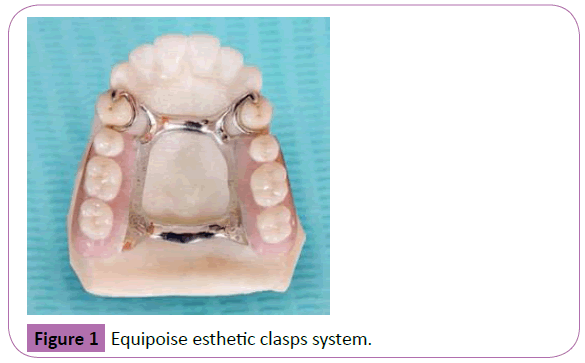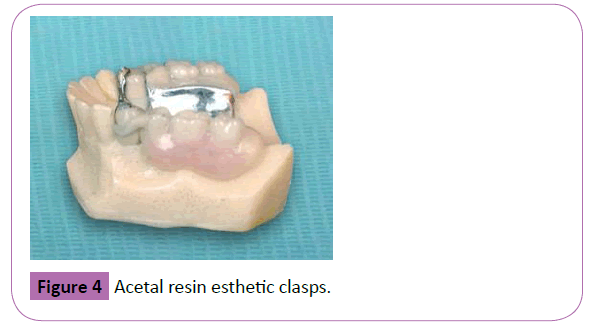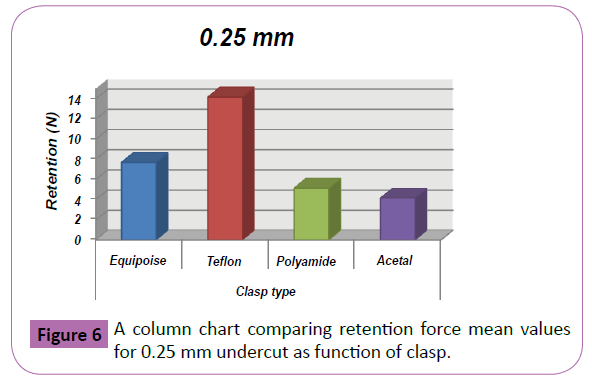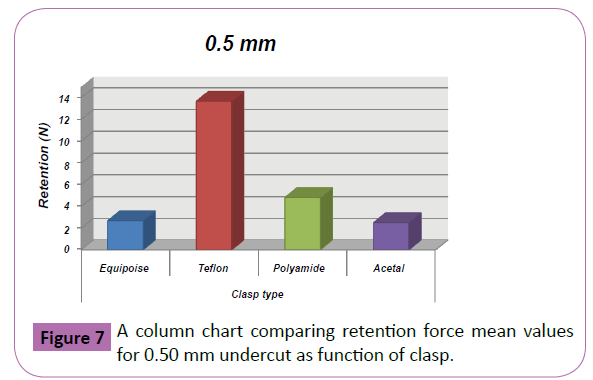Keywords
Esthetic clasps; Metal free clasps; Retentive undercuts values; In vitro study
Introduction
In an era of implants and fixed prosthesis, the removable partial dentures (RPDs) are up to this time a treatment of decision for an extensive variety of patients and clinicians [1]. Patients often question to the placement of a metal clasp if it is a visible part of removable partial dentures (RPDs) [2].
These days, there is an expanding of the accentuation on aesthetic, dental specialist have been worried about giving aesthetics and functional RPDs to their patients and this made the mission more troublesome in view of the objective now is accomplishing ideal aesthetic of the denture, while looking after retentive, stable, and wellbeing of supporting tooth and supporting tissue [3].
Numerous systems to defeat this quandary incorporate; the use of lingual positioned clasp, [4] the painting of clasps with tooth colored resins, [5] engaging of mesial rather than distal undercut [6]. RPDs without metal clasps has recently been utilized as a part of dentistry [7,8].
The Equipoise clasp is a retentive lingual back action clasp which encloses more than 180° of the greatest circumference of tooth, be reached out from the mesial and surround to the lingual and distal surfaces of the tooth to engage the distobuccal undercut. Equipoise pities the abutment tooth as it disengages when the partial denture is in function [9]. Masking of clasps can be done using acrylic resin or composite material. The contradictorily in the coefficients thermal expansion of metal and these materials represent an issue [10].
An extensive number of thermoplastic resins have been produced for the development of a “nonmetal clasp denture”, in a broad sense to achieve anterior retention that fulfills esthetic requirements. The stability of nonmetal clasp dentures can be enhanced by including a metal rest or framework to this denture. To an extent it is known that, all producers of thermoplastic resins and labs of nonmetal clasp dentures have suggested the first denture configuration, including the resin clasp design, from a self-governing point in view; this issue has never been illuminated from an investigative purpose of view [2].
In a perfect world, the retentive force of clasp is somewhat more prominent than the normal retentive force. This force as the case may be superfast in deeper undercuts; different clasps were inspected for this speculation with a specific end goal to examine their retentive force [11].
This research aimed to study the effect of clasp, design, material, and amount of retentive undercut of esthetic clasp on retention of removable partial dentures restoring maxillary Kennedy class I RPDs.
Materials and Methods
This In vitro study was done on eight standard educational acrylic resin models (BH303; Nissin Dental Products Inc., Kyoto, Japan) represent maxillary Kennedy class I cases. The remaining teeth were extending from the right first premolar to the left first premolar teeth.
Both first premolar teeth of each model were prepared to receive full ceramo-metal crowns with mesial occlusal rest seat, proximal guiding planes, and different mesio-buccal retentive undercuts of 0.25 mm in three models from the eight models, and 0.50 mm in other three models. The remaining two models have the retentive undercuts on the distobuccal surface of the tooth with either depth of 0.25 mm and 0.50 mm respectively.
Educational models with the retentive undercuts on the distobuccal surface of the first premolar with either depth of 0.25 mm and 0.50 mm were received two metallic RPDs retained by Equipoise clasps fabricated by cobalt-chromium alloy material (Star Loy C® Degudent, Dentsply, Petropolis, Brazil). Another two educational models with the retentive undercuts on the mesiobuccal surface of the first premolar with either depth of 0.25 mm and 0.50 mm were received two metallic RPDs retained by RPA clasps fabricated by cobalt-chromium alloy. The retentive arm covered with Teflon tube. Another two educational models with the retentive undercuts on the mesio-buccal surface of the first premolar with either depth of 0.25 mm and 0.50 mm were received two metallic RPDs retained by RPA clasps in which the retentive arm fabricated by polyamide material (Deflex Nuxen SRL, Buenos Aires, Argentina). The last two educational models with the retentive undercuts on the mesio-buccal surface of the first premolar with either depth of 0.25 mm and 0.50 mm were received two metallic RPDs retained by RPA clasps in which the retentive arm fabricated by Acetal resin (Valplast Int. Corp. USA).
For the casts of Equipoise clasp
Each educational acrylic model was duplicated to produce a total of six refractory cast. Each cast was waxed by readymade wax to design partial denture frame works with anteroposterior palatal strap major connector, single minor connector continued over the marginal ridge bilaterally terminated with mesial occlusal rest, proximal plates on the distal proximal surfaces of the last abutments, and saddles bilaterally. A tapered half-round clasp wax pattern was adapted to the top of the minor connector and runs palatally, downward and distally above the height of contour of the abutment to engage finally in the distobuccal retentive undercut to form the Equipoise clasp arm. The wax pattern was sprued, invested, burned out; metal casted, electro-polished (Figure 1).

Figure 1: Equipoise esthetic clasps system.
For the casts of RPA clasp covered with Teflon tube
Each educational acrylic model was duplicated to produce a total of six refractory cast. Each cast was waxed as in group I with exception in clasp design, which was RPA clasp raised from proximal plate and runs buccally, down ward and mesially above the height of contour of the abutment to engage finally in the mesio-buccal retentive undercut. After Sprued, invested and metal framework constructed as same as group I, the clasps were covered by Teflon tube (Figure 2).

Figure 2: RPA clasp covered by Teflon tube.
For the casts of clasp with polyamide material
Each educational acrylic model was duplicated to produce a total of six refractory cast. Each cast was waxed as in group I with exception of the clasp design, which was RPA clasp as in group II. A special square aluminum flask (Roko flask, USA) was used; the wax pattern was sprued, invested. The wax was washed out by clean hot water and steam. Multipress eco (Roko, USA) machine was adjusted to the preset program for the deflex polyamide material, which adequate quantity of the deflex polyamide material transparent type was loaded into a disposable cartridge. The material was injected at 280°C. When the temperature and pressure were at appropriate, the start/injection key was pressed. After 20 minutes, the flask was removed followed by devesting, the sprue was cut. Finishing and polishing was done. The acrylic artificial teeth were fitted on the free end saddle of the framework (Figure 3).

Figure 3: Polyamide esthetic clasps.
For the casts of clasp with Acetal resin material
Each educational acrylic model was duplicated to produce a total of six refractory cast. Each cast was waxed as in group I with exception of the clasp design, which was RPA clasp as in group II. The wax was sprued, invested and flasked as group III. Adequate quantity of the Bio-Dentaplast material was loaded into a disposable cartridge. Thermo press 400 machine (Bredent, Germany) was adjusted to the preset program for the Bio- Dentaplast material. After injected the material, the flask was removed followed by devesting, the sprue was cutted. Finishing and polishing was done (Figure 4).

Figure 4: Acetal resin esthetic clasps.
For all groups the following steps were done
A small metal ring hook was soldered to the occlusal rest of each clasp assembly parallel to the path of insertion using the surveyor to pullout the cast clasps later. A movable custom made jig was used to clutch the master cast inside small upward opened container perpendicular to the pulling chain. Each clasp was seated manually to be pulled by the jig of the universal testing machine (UTM) (Shimazdu testing machine AG-X, 10N-10KN, Japan). The UTM applied a tensile load at crosshead speed of 5 mm/min until automatically stopped. This procedure was repeated 10 times for each cast (Figure 5).

Figure 5: The universal testing machine.
Statistical Analyses
Statistical analysis was performed using Aasistat 7.6 statistics software for Windows (Campina Grande, Paraiba state, Brazil). Data analysis was performed in several steps. Initially, descriptive statistics for each group results. Two-factor ANOVA test were performed to detect significance between variables (clasp and undercut). One way ANOVA followed by Tukey’s post-hoc tests were performed to detect significance between groups within each undercut. Student t-test was performed to detect significance between main subgroups. P values ≤ 0.05 are considered to be statistically significant in all tests.
Results
Table 1 illustrates descriptive statistics of maxillary Kennedy Class I RPDs retention force as function of aesthetic clasp type engaging different retentive undercuts depths.
| |
0.25 mm |
0.5 mm |
| Mean X |
± SD |
Min. |
Max. |
Mean X |
± SD |
Min. |
Max. |
| |
Group I |
7.69 |
± 1.12 |
6.43 |
9.82 |
2.68 |
±0.77 |
1.45 |
5.03 |
| Aesthetic |
Group II |
14.18 |
± 1.12 |
11.98 |
16.97 |
13.66 |
± 1.76 |
10.5 |
19.36 |
| Clasp |
Group III |
5.15 |
± 1.21 |
3.43 |
9.41 |
4.83 |
± 1.17 |
2.95 |
8.55 |
| |
Group IV |
4.15 |
± 1.35 |
1.41 |
6.44 |
2.51 |
± 0.98 |
1.14 |
4.18 |
Table 1: Descriptive statistics of maxillary Class I removable partial denture retention force.
Table 2 broadens Paired t-test of maxillary Kennedy Class I RPDs retention force constructed with different aesthetic clasps engaging different undercut depths. For Equipoise aesthetic clasp It was found that 0.25 mm- retentive undercut showed high retention force mean value (7.69 ± 1.12 N) than the 0.5 mm retentive undercut (2.68 ± 0.77 N). This difference in retention force is statistical significant. For RPA clasp covered by Teflon tube; it was found that 0.25 mm- retentive undercut recorded a higher retention force mean value (14.18 ± 1.12 N) than the 0.5 mm retentive undercut (13.66 ± 1.76 N). This difference in retention force is statistical insignificant. For polyamide aesthetic clasp; it was found that 0.25 mm retentive undercut recorded a higher retention force mean value (5.15 ± 1.21 N) than the 0.5 mm retentive undercut (4.83 ± 1.17 N). This difference in retention force is statistical insignificant. For Acetal resin aesthetic clasp it was found that 0.25 mm retentive undercut recorded a higher retention force mean value (4.15 ± 1.35 N) than the 0.5 mm retentive undercut (2.51 ± 0.98 N). This difference in retention force is statistical significant (Figures 6 and 7).
| |
Variable |
MeanX |
± SD |
Statistics |
| Group I (Equipoise aesthetic clasp) |
0.25 mm |
7.69 |
± 1.12 |
P value |
| 0.5 mm |
2.68 |
± 0.77 |
<0.0001* |
| Group II (RPA clasp covered by Teflon tube) |
0.25 mm |
14.18 |
± 1.12 |
P value |
| 0.5 mm |
13.66 |
± 1.76 |
0.3977 ns |
| Group III (polyamide aesthetic clasp) |
0.25 mm |
5.15 |
± 1.21 |
P value |
| 0.5 mm |
4.83 |
± 1.17 |
0.5056 ns |
| Group IV (Acetal resin aesthetic clasp) |
0.25 mm |
4.15 |
± 1.35 |
P value |
| 0.5 mm |
2.51 |
± 0.98 |
0.0315 ns |
Table 2: Comparison of the retention force results (Mean ± SD) for different aesthetic clasps as function of retentive undercut type.

Figure 6: A column chart comparing retention force mean values for 0.25 mm undercut as function of clasp.

Figure 7: A column chart comparing retention force mean values for 0.50 mm undercut as function of clasp.
Table 3 represents two-factor analysis of variance ANOVA test (P<0.0001) to compare the retention force of different aesthetic clasps when they engage the 0.25 mm retentive undercut; it was found that RPA clasp covered by Teflon tube recorded the highest retention force mean value (14.18 ± 1.12 N) followed by Equipoise aesthetic clasp (7.69 ± 1.12 N) then polyamide aesthetic clasp, (5.15 ± 0.34 N) while Acetal resin aesthetic clasp recorded the lowest retention force mean value (4.15 ± 1.35 N). The difference between Equipoise aesthetic clasp and RPA clasp covered by Teflon tube was statistically significant, although the Pair-wise Tukey’s post-hoc tests showed statistical insignificant (p>0.05) difference between polyamide aesthetic clasp and Acetal resin aesthetic clasp.
| |
Variable |
MeanX |
± SD |
Rank |
Statistics |
| 0.25 mm undercut |
Group I (Equipoise
aesthetic clasp) |
7.69 |
±1.12 |
B |
P value<0.0001* |
| |
group II (RPA
clasp covered by
Teflon tube) |
14.18 |
±1.12 |
A |
|
group III (polyamide
aesthetic clasp) |
5.15 |
±1.21 |
C |
|
group IV (Acetal
resin aesthetic clasp) |
4.15 |
±1.35 |
C |
|
Table 3: Comparison of the retention force results (Mean ± SD) for 0.25 mm retentive undercut as function of aesthetic clasp.
Table 4 show two-factor analysis of variance ANOVA test (P<0.0001) to compare the retention force of different aesthetic clasps when they engage the 0.5 mm retentive undercut; it was found that RPA clasp covered by Teflon tube recorded the highest retention force mean value (13.66 ± 1.76 N) followed by polyamide aesthetic clasp (4.83 ± 1.17 N) then Equipoise aesthetic clasp (2.68 ± 0.77 N) while Acetal resin aesthetic clasp recorded the lowest retention force mean value (2.51 ± 0.98 N). The difference between groups was statistically significant, although the Pair-wise Tukey’s post-hoc tests showed statistical insignificant (p>0.05) difference between Equipoise aesthetic clasp and Acetal resin aesthetic clasp.
| |
Variable |
MeanX |
± SD |
Rank |
Statistics |
| 0.5 mm retentive undercut |
Group I (Equipoise aesthetic clasp) |
2.68 |
± 0.77 |
C |
P value<0.0001* |
| |
Group II(RPA clasp covered by Teflon tube) |
13.66 |
± 1.76 |
A |
|
Group III
(polyamide aesthetic clasp) |
4.83 |
± 1.17 |
B |
group IV (Acetal resin aesthetic
clasp) |
2.51 |
± 0.98 |
C |
Table 4: Comparison of the retention force results (Mean ± SD) for 0.5 mm retentive undercut as function of aesthetic clasp.
Discussion
In vitro studies be upset from imperfection; Firstly, the RPDs movements intraoral is not only treated with mechanical considerations, however be conditional on the neuromuscular movement of the patient. Secondly, the modality of loading intraoral is markedly more complex than the implementation of load In vitro. Finally, the oral mucosa is fabricated with soft acrylic resin material that is various than the intraoral normal mucosa of the patient [12].
When a retentive undercut is not be located with a surveyor on the abutment tooth, it may be formed artificially by a class V restoration, reshaping of enamel surface, or silhouetting with composite resin, or constructing a ceramo-metal crown to felicitous the RPD direct retainer [13]. In this study a ceramometal crowns were fabricated on both abutments teeth to produce the predetermined retentive undercuts.
Sato et al. [14] concluded that the retentive force of 5 N is desired for appropriate function of PRDPs, while Frank et al. [15] stated that the retentive force of 3 to 7.5 N be a symbol for a convenient amount of retention for a maxillary Kennedy class I RPDs. In this study for 0.25 mm retentive undercut all clasp groups achieve acceptable amount of retention, but for 0.50 mm retentive undercut only RPA clasp covered with Teflon tube and polyamide aesthetic clasp were possess adequate amount of retention, while Equipoise aesthetic clasp, and Acetal resin aesthetic clasp were not possess adequate amount of retention.
The amplitude of undercut depth significantly affected the clasp retentive force. Keeping the other clasp related factors constant while positioning of the retentive tip at deeper undercut resulted in marked increment of retentive force. In this study, regardless of clasp type, totally it was found that 0.25 mm retentive undercut recorded a higher retention force than the 0.50 mm retentive undercut. However with 0.25 mm undercut it was found that RPA clasp covered by Teflon tube recorded the highest retention force, followed by Equipoise aesthetic clasp, then polyamide aesthetic clasp, while Acetal resin aesthetic clasp recorded the lowest retention force, but with 0.50 mm undercut it was found that RPA clasp covered by Teflon tube recorded the highest retention force, followed by polyamide aesthetic clasp, then Equipoise aesthetic clasp, while Acetal resin aesthetic clasp recorded the lowest retention force. This is in accordance with the research of Abdulhadi et al. [11] who deducted that the amplitude of retentive undercut depth significantly influenced the clasp retentive force. Keeping the other clasp related factors constant while positioning of the retentive tip at deeper undercut resulted in marked increment of retentive force.
The retentive force of an acetal resin aesthetic clasp perhaps is not sufficient for maxillary Kennedy class I RPDs retention because of the significantly low retentive force result from the low modulus of elasticity of acetal resin. But the acetal resin aesthetic clasps may be suitable for RPDs when aesthetics or periodontal health of abutment teeth is the primary concern [16]. The results of the present study verify these findings, which an Acetal resin clasps group recorded the lowest retention force in both 0.25 mm and 0.50 mm undercut depths.
Conclusion
Within the limitations of this study, it was concluded that: RPA clasp covered by Teflon tube may be considered a promising clasp regarding retention, however, rapid wear of Teflon cover, even with it is easy replacement, and is still hindering its wide use.
Equipoise aesthetic clasp in undercut 0.25 mm, gives an acceptable retentive value. Polyamide aesthetic clasp is a recommended clasp to maximize retention in undercut area of 0.50 mm, which is unfavorable for casted Co-Cr clasps. Acetal resin clasps have the lowest retention force in all groups in both undercut depths.
Conflict of Interest
The authors claim to have no financial interest, either directly or indirectly, in the products or information listed in the article.
References
- Sharma A, Shashidhara HS (2014) A Review: Flexible Removable Partial Dentures. JDMS 13: 58-62.
- Osada H, Shimpo H, Hayakawa T, Ohkubo Ch (2013) Influence of thickness and undercut of thermoplastic resin clasps on retentive Force. Dent Mater J 32: 381-389.
- Alwan S, Ismail I (2014) Retentive forces, tensile strength and deflection fatigue of Acetal thermoplastic clasp material in comparison with cobalt-chromium alloy. J BaghColl Dentistry 26: 59-66.
- Aras Sh (2013) Esthetics in Removable Partial Denture - A Review. Univ Med J 44: 344-348.
- Ozcan M (2002) The use of chair side silica coating for different dental applications: a clinical report. J Prosthet Dent 87: 469-472.
- Tang MW, Aristidou GA, Djemal S (2013) Unilateral bounded saddles: a clinical case report on the use of a two part sectional removable partial denture. Eur J ProsthodontRestor Dent 21: 16-23.
- Kaplan P (2008) Flexible removable partial dentures: Design and clasp concepts. Dent Today 27: 122-123.
- Goiato MC, Panzarini SR, Tomiko C, Luvizuto ER (2008) Temporary flexible immediately removable partial denture: A case report. Dent Today 27: 114-116.
- Hundal M (2014) Esthetic Cast Direct Retainers for Distal Extension Removable Partial Dentures. Oral Hyg Health 2: 1-3.
- Aras M, Chitre V (2005) Direct retainers: Esthetic solutions in the smile zone. The Journal of Indian Prosthodontic Society 5: 4-9.
- Abdulhadi L, Mourshed B (2010) clasp retention using variable undercuts depths. Dentika dent J 15: 20-23
- Setz JM, Wright PS, Ferman AM (2000) Effects of attachment type on the mobility of implant-stabilized overdentures an in vitro study. Int J Prosthodont 13: 494-499.
- Helal MA, Baraka OA, Sanad ME, Ludwig K, Kern M (2012) Effects of long term simulated RPD clasp attachment/detachment on retention loss and wear for two clasp types and three abutment material surfaces. J Prosthodont 21: 370-377.
- Sato Y, Tsuga K, Abe Y, Asahara S, Akagawa Y (2001) Analysis of stiffness and stress in I-bar clasps. J Oral Rehabil 28: 596-600.
- Frank RP, Nicholls JI (1981) A study of the flexibility of wrought wire clasps. J Prosthet Dent 45: 259-267.
- Saad El-Din M, Gebreel A, Swedan M (2014) Thermoplastic Distal Extension Removable Partial Dentures versus Vitallium ones -Radiographic Evaluation. M J Dent 1: 20-23.








